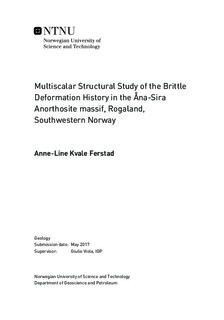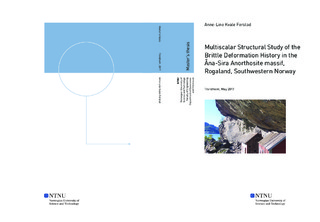| dc.description.abstract | The c. 930 Ma Åna-Sira anorthosite massif (ÅS) is a part of the Rogaland Anorthosite Province, situated in the county of Sokndal, Rogaland. In this thesis, multiscalar efforts are aimed at unraveling the spatial and temporal evolution of the highly fractured and faulted basement in the study area. Five prominent lineament systems (N-S, ENE-WSW, NE-SW, WNW-ESE, NW-SE) are distinguished using lineament mapping and give important information about the main spatial distribution of fractures and faults. Lineament maps, together with detailed structural mapping, microstructural analysis and radiometric dating reveal several deformation phases in ÅS. Rapid cooling of the c. 930 Ma old magmatic body generated cooling joints. The intrusion of the Fe-Ti-norite dikes 10 Ma later, exploited the cooling joints generating NW-SE trending structures which were later displaced by NE-SW trending structures. Further deformation was accommodated by NE-SW directed oblique extension leading to the emplacement of Egersund dike swarm and formation of WNW-ESE trending structures c. 616 Ma ago. During the Cambrian, Caledonian contraction caused top-to-SE displacement with folding of NE-SW trending faults that were later reactivated in a brittle fashion with top-to-NW normal faulting due the Caledonian extensional collapse in Devonian. Extensional normal reactivation of the inherited faults occurred during three phases in the Mesozoic generating N-S, WNW-ESE and NE-SW trending structures and development of gouge-rich and brecciated rocks.
Detailed mesoscopic, microstructural and radiometric analysis of the important large-scale NE-SW trending Helleren Fault Zone (HFZ) revealed several different processes leading to strain localization within the fault. Rapid cooling of the anorthosite in the Neoproterozoic caused the formation of cooling joints, allowed for the ingress of fluids and percolation of new minerals, whereby alteration of the anorthosite along the veins weakened the HFZ. When early NW-SE directed, Caledonian shortening (Cambrian) affected the HFZ, strain localized along the cooling joints creating local foliation at the HFZ with a protomylonitic texture implying top-to-SE reverse transfer. Increasing lateral displacement during the Silurian continent-continent collision caused folding of the fault. The latest deformation was accommodated by a shift in the stress field due to the extensional collapse of Caledonian Orogeny, and caused normal top-to-NW brittle faulting of the HFZ. By utilize K/Ar dating of synkinematic illite, the timing of the last temporal evolution of multiply-reactivated brittle-ductile HFZ is constrained. All the ages vary as a function of grain size, whereby ages decrease with decreasing grain size. The results from the radiometric dating display a final fault increment (finest grain size) at the Helleren Fault Zone at 403 ± 10 Ma, related to Caledonian extension and collapse of the orogeny. | |

